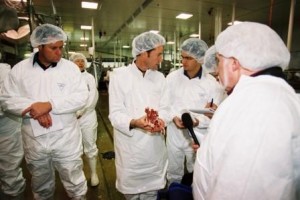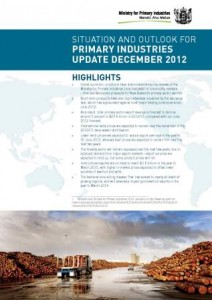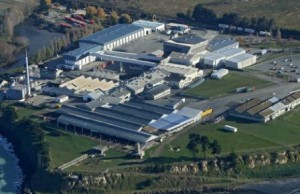 It’s been an eventful year for meat training, with the merger of the meat and dairy sectors’ industry training organisation (NZITO) and the Seafood ITO to create a major export food ITO, which is generating synergies that will benefit all.
It’s been an eventful year for meat training, with the merger of the meat and dairy sectors’ industry training organisation (NZITO) and the Seafood ITO to create a major export food ITO, which is generating synergies that will benefit all.
The new single ITO entity, using the NZITO name and branding, has been in operation since the beginning of August and is now servicing a combined workforce of over 60,000 employees covering New Zealand’s three key export food industries – meat, dairy and seafood.
“There are many obvious synergies we are now taking up, such as knife skills and rendering and there will be more shared servicing over time as we maximise staff and training to keep costs in check,” reports general manager Carl Ammon, who has stepped up from leading the meat and dairy ITO to head the new body, adding that there are new skills in the team that are all adding value.
Ammon is delighted to share that the new NZITO is delivering at the top of the Tertiary Education Commission’s Educational Performance Indicator tables. “Which is creditable as our industries are seasonal and not based around trade apprenticeships, unlike building or engineering,” he says.
The move to a single enlarged ITO has been strongly supported by the Meat Industry Association (MIA) with chief executive Tim Ritchie pointing out that ITOs provide training that many people would not otherwise get, as it is delivered in the workplace and allows for the seasonal pressures of the agricultural industry.
“The ITO system is an invaluable asset for out industry, and this merger can only make it stronger. The merged ITO will allow our people to learn and up-skill themselves while they work and offers clear opportunities for career development in our industry.”
When he announced the merger, NZITO chair Graeme Sutton said that training offered through the NZIITO will carry more status in the primary sector and the community as a whole.
a whole.
Because of its increased ‘buying power’, Sutton said that the ITO will be able to demand high standards of delivery from its training providers. There will also be greater emphasis on training skills that are transferable across the food export sector, creating more opportunities for personal advancement, he said.
The new NZITO board includes two representatives each from the meat, dairy and seafood industries. Representing the MIA, and the meat industry, on the board are Carolyn Thompson, HR Manager for Taylor Preston Ltd and Kerry Stevens, Group HR and Communications Manager for Alliance Group Ltd.
There is also a meat advisory group (MAG), comprising representatives from a number of meat companies, which provides industry input to the NZITO. Similar groups have been set up for the dairy and seafood sectors.
Qualifications now under review
Recent work for the groups includes input to the nation-wide Targeted Review of Qualifications (TRoQ), aimed at simplifying the qualification framework, rationalising the number of qualifications and seeing where updates are needed. Proposals are expected to go forward to NZQA in early 2013.
The work is going well, says Ammon, adding that it is using best practice examples between sectors and will allow for qualifications that are simpler to follow and use and that still provide a learning pathway for staff.
“We are focusing on the generics and people skills like communications, problem solving and team work as well as food safety, market access, quality, biosecurity and supply chain.”
Apprenticeship pathways, proving very popular for meat companies and others, are to be rebuilt. “This uses the qualifications and packages them to the level of a well-rounded and capable operator able to take on technical and leadership responsibility.”
The TRoQ review is also building in the future needs that are arising from drivers like automation and robotics that are now expanding in use across the sector. “This mirrors past experience in the dairy industry, so we can benefit from that experience here,” says Ammon.
Health and safety skills and knowledge are being integrated into core training, alongside the running of specialist Occupational Health and Safety qualifications.
Management development and productivity improvement qualifications are being retained, “as these have been used to good advantage by many companies in building both people and organisational performance,” says Ammon.
The NZITO is also planning to implement with other ITOs, such as hospitality, a base food sector qualification aimed at schools and pre-employment. “This will reinforce the career pathways plan of the Ministry of Education and support trade academies and schools delivering trade-focused skills to students who have a career planned in industry.”
What’s next?
The NZITO is now working closely with other primary sector ITOs in the planning of a primary sector platform to coordinate qualifications and training. That will harmonise with Ministry of Primary Industries (MPI) requirements in areas like traceability, transport and animal welfare.
“This will help us to harmonise much that is in common in the food export areas and is intended to reinforce the value chain or paddock to plate concept this is a key driver in New Zealand exports,” Ammon explains.
Practical examples would be common HACCP training standards, animal welfare, animal products inspection and initiatives like halal standards for key markets. “This is also intended to complement our adaptation to expectations from key markets for a standards based approach to the supply chain,” he says.
The NZITO/Seafood ITO merger is part of the reconfiguration of the ITO sector into larger, more capable organisations to better meet the needs of employers. In October, the agriculture and horticulture ITOs also merged into one organisation, under the Primary Industry Training Organisation banner.
“Work is progressing on the prospect of a consolidated primary sector ITO that will deliver greater efficiencies in scale, coverage (market share) and resourcing flexibility,” says Ammon. “Early work shows real potential for savings and improved services so this will be a work in progress for 2012/2013.”
This item appeared first in Food NZ magazine (December 2012/January 2013).
 New Zealand’s meat processors and farmers can expect lower lamb prices over the remainder of the 2012/2013 production season, while beef prices are expected to remain firm over the next two years, says the Ministry of Primary Industries (MPI).
New Zealand’s meat processors and farmers can expect lower lamb prices over the remainder of the 2012/2013 production season, while beef prices are expected to remain firm over the next two years, says the Ministry of Primary Industries (MPI).









